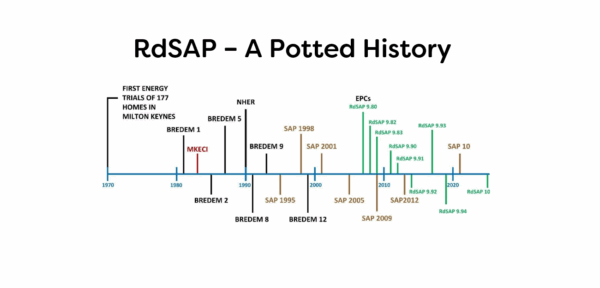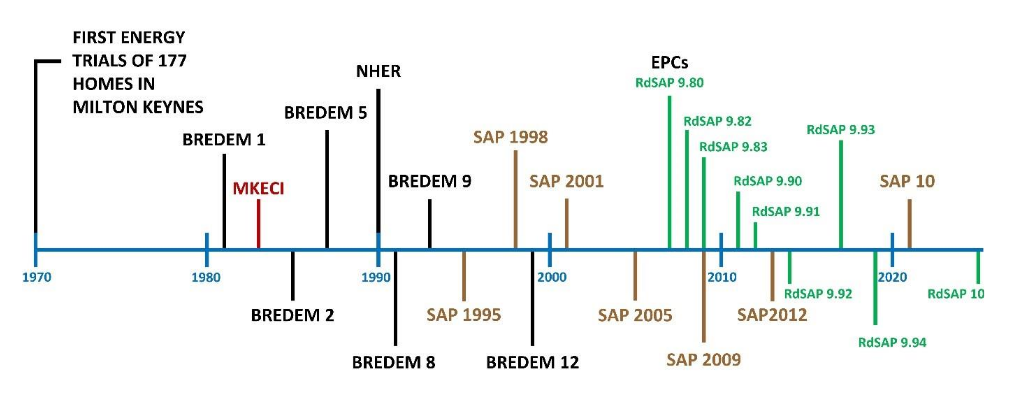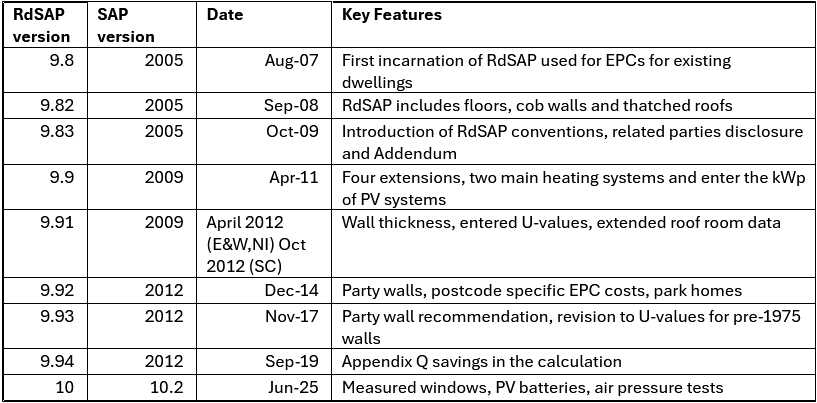RdSAP – A Potted History .

The Milton Keynes Energy Cost Index (MKECI) was introduced in 1983 and was the predecessor to the current energy ratings. The MKECI was followed by the National Home Energy Rating (NHER) in 1990 and then the Standard Assessment Procedure (SAP).

SAP was introduced for the first time in 1995 as the basis of a new approach to Building Regulations for new homes. It was subsequently updated in 1998, 2001, 2005, 2009 and 2012 for each successive update to the Building Regulations. Each revision of SAP re-evaluates the carbon emissions factors and new technologies that have been introduced and need to be included in the methodology.
RdSAP, based on SAP 2005, was created for the introduction of Energy Performance Certificates (EPCs) for existing dwellings in August 2007 (RdSAP 9.80). Since then, there have been 8 updates to RdSAP to add additional data items, to support the introduction of RdSAP Conventions, and to align with new versions of SAP; these were RdSAP 9.82, 9.83, 9.90, 9.91, 9.92, 9.93, 9.94 and 10.
RdSAP 9.90 was introduced in April 2011, based on SAP 2009. The change to SAP 2009 meant more data collection for Domestic Energy Assessors (DEAs) including the ability to specify two main heating systems to better reflect what the DEAs were finding during their surveys.
In April 2012, RdSAP 9.91 was introduced still using SAP 2009 but now including the ability to specify renewable systems and specific insulation products using the new ‘overwriting U-value’ functionality. This update was focused on getting RdSAP ready for Green Deal which was introduced in January 2013.
RdSAP 9.92 was introduced in December 2014, based on SAP 2012. This update included party walls and additional heating control options.
RdSAP 9.93, was based on SAP 2012 and included a new party wall recommendation as well as revisions to the underlying default U-values for walls. There was no change to the data entry requirements for RdSAP 9.93 compared to RdSAP 9.92.
RdSAP 9.94, uses SAP 2012 and was introduced on 22nd September 2019. This version of RdSAP included the ability to include the benefits from special features. Special features are technologies yet to be included in the SAP methodology or product characteristics database, such as dynamic insulation or smart air bricks.
See https://sava.co.uk/sava-edge/what-is-rdsap-9-94/
The latest version, RdSAP 10, was introduced on 15th June 2025 and included many changes alongside the change in the SAP methodology to SAP 10.2. The introduction of PV batteries, measured windows and the ability to record specific insulation characteristics should deliver more accurate energy efficiency calculations and help homeowners identify effective improvements.
See https://sava.co.uk/sava-edge/what-is-rdsap-10/
